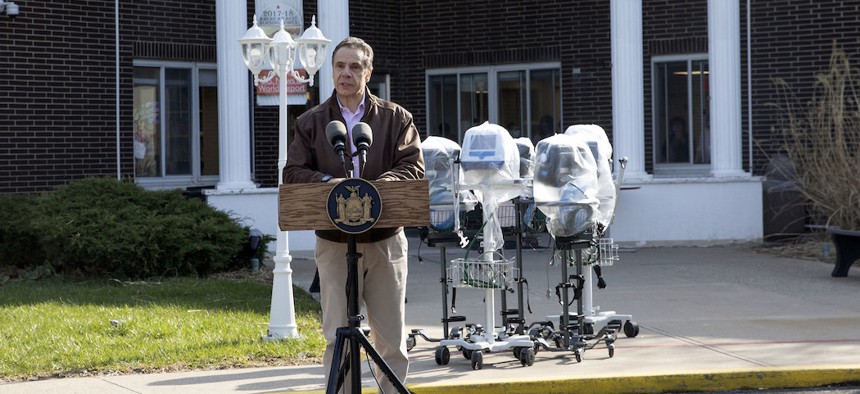New Yorkers have learned a lot in recent weeks about how hard COVID-19 hit nursing homes last year. State Attorney General Letitia James issued a scathing report that said the state Department of Health undercounted the deaths of nursing homes residents who later died at hospitals. The department finally responded Wednesday to 20 questions sent by state lawmakers months ago. Hours later, the state met a court-ordered deadline to release data showing how many nursing home residents later died of COVID-19 in hospitals.
This deluge of new information raises as many questions as it answers, according to state lawmakers, critics and experts who say Gov. Andrew Cuomo has withheld key information about the true extent of COVID-19 in long-term care facilities. While his administration appears to be taking a more cooperative approach to satisfying its critics compared to months ago, ongoing controversies over the governor’s handling of the coronavirus in nursing homes appear to only be getting bigger.
“There’s a lot of questions that need more clarity,” Assembly Member Ron Kim, one of several Democratic lawmakers who met virtually with Cuomo administration officials Wednesday, said in an interview with City & State. “I’ve got a feeling that this is just the beginning and it’s going to still be a hot-button issue moving forward.”
Some of the controversies surrounding nursing homes are undeniably political. Republicans say Democrats are not standing up to the governor while Democrats say GOP lawmakers are acting in bad faith. Some outstanding issues, however, come down to clear matters of fact. Here are a few of the questions that the state is just beginning to answer.
What is the total number of nursing home residents who died in hospitals?
According to new data released by the state on Feb. 10 after a six-month legal battle with the Empire Center for Public Policy, a conservative think tank, 4,775 New York nursing home residents died of COVID-19 after being transferred out of their nursing homes. There were an additional 6,344 confirmed deaths of COVID-19 at nursing homes and 2,981 presumed deaths of COVID-19 at nursing homes. “The department’s response falls short of what was requested,” reads a Feb. 10 press release from the center. “The records do not fully account for the deaths of some 600 residents that occurred outside of the long-term care facilities, most often in hospitals, in which the COVID-19 diagnosis was presumed rather than confirmed.” The state Department of Health has yet to provide dates from those deaths, though a spreadsheet it sent to the center lists the names, county, ZIP code and dates of deaths at a total of 10,188 congregate care facilities.
How much immunity is too much for nursing homes?
Assembly Member Ron Kim, whose uncle died of COVID-19, said the Cuomo administration had a surprisingly conciliatory attitude at a Feb. 10 virtual meeting with Democratic state lawmakers, especially when it came to addressing outstanding concerns about the current legal immunity for nursing homes that legislators approved in March last year, which was then partially repealed in August. “It was not a full admittance that they got it wrong,” Kim said in an interview. “But they recognized that it’s problematic to get this type of broad immunity to nursing homes.” The health department did not exactly put it that way in a written response to lawmakers’ questions on the matter, but it did acknowledge that the governor signed the proposed changes into law. Whether Cuomo would support additional changes remains to be seen, but Kim said he left the meeting feeling encouraged by the “surprising openness” of the administration.
Why can’t the state make it easier for people to visit their family members?
The state is allowing stadiums to reopen to a small number of fans later this month. Indoor dining is resuming soon in New York City. Yet, it can still be pretty hard for people to see their loved ones at nursing homes. “We have been pushing to register at least one or two family members to be an essential worker (who) can go in and visit,” Kim said of outstanding efforts to loosen visitation rules, but the Cuomo administration has yet to back that idea. It also remains unclear when visitations can resume at 400 out of the 613 nursing homes in the state. “Nursing homes are allowed to resume limited visitation for facilities that have been without COVID-19 for at least 14 days,” reads the official health department response to lawmakers. “The Department will continue to be guided by science and concern for residents’ welfare.
Where are these previously unknown “COVID-19-only nursing homes” located?
Somewhere in the Empire State are 19 facilities that have been exclusively devoted since November to housing as many as 1,941 people who have COVID-19, the state Health Department revealed in its 16-page letter to lawmakers. “The homes were established to allow the transfer of MEDICALLY STABLE, BUT persistently positive COVID-19 nursing home eligible patients from Article 28 hospitals to these nursing homes to further their recovery prior to discharge to home or another nursing home,” reads the letter, which does not disclose the locations of these sites, who manages them and how many people are currently there.
NEXT STORY: How COVID-19 has highlighted housing issues


